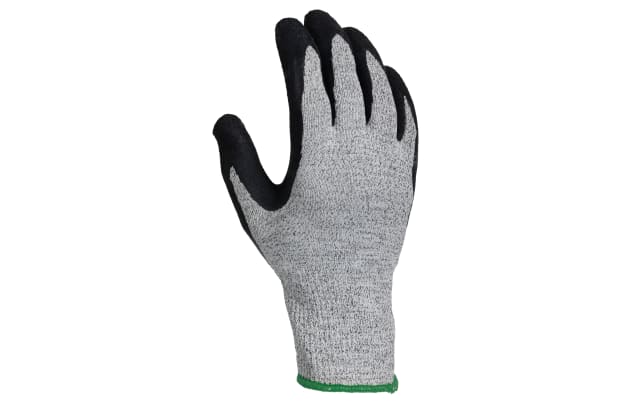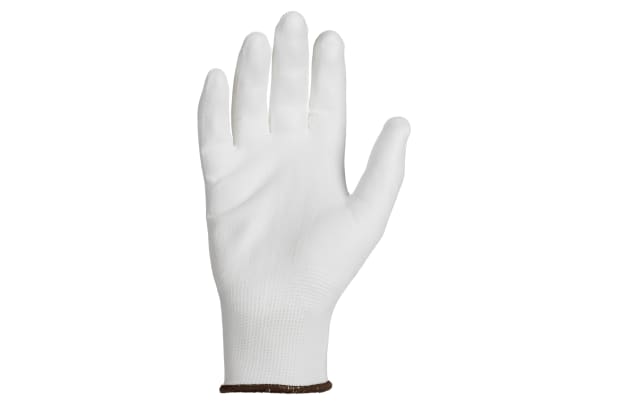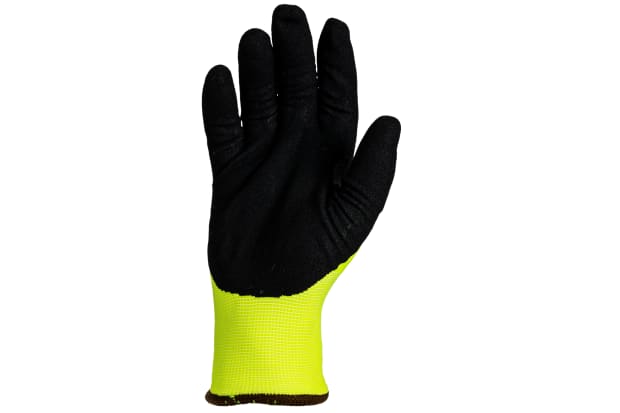- Published 24 Jan 2023
- Last Modified 29 Aug 2023
- 14 min
A Complete Guide to Work Gloves
Our guide is designed to help you understand work gloves, their applications, types, features and materials.

In this guide to safety work gloves, we will outline the basic key functions of numerous different types of workplace hand coverings. This guide aims to help you decide which sort of workers’ gloves will best suit your intended environment and application.
What are Work Gloves?
Work gloves are a broad category of personal protective equipment (PPE) that can cover a highly diverse range of different product types, materials and functions.
In most cases, workwear gloves perform at least one key role, often several. These generally relate to either employee convenience and comfort, hand protection for improved user safety, product preservation, or general cleanliness and hygiene.
Applications of Work Gloves
Various types, styles and materials of safety gloves are worn across many different professions and workplace environments. These include:

Mechanic Gloves
Mechanic gloves are typically durable, hardwearing fabric-based products, designed for multiple uses over an extended period. They are often made from either nylon or elastane, giving a close fit that enables greater user dexterity.
High-quality mechanics’ gloves will often be enhanced with materials such as polyamide or nitrile foam in the palm and finger grip areas. These can offer significantly improved performance when handling small or delicate components.
Some key features to look out for when searching for mechanics gloves might include:
- Excellent grip
- Reliable performance in both wet and dry conditions
- Advanced fabrics and manufacturing techniques for improved resilience
- High-tech palm and/or finger coatings to improve performance
- Breathability in certain areas, such as on the back of the hand, for increased user comfort
- Designed to allow for a range of dermatology sensitivities, e.g. catalyst and solvent-free
- Strong resistance to abrasion and tearing, offering far longer service life than disposable gloves
Mechanic gloves are also used in other professions, including warehousing and supply chain, scaffolding, electronics and engineering, white goods manufacturing, light assembly tasks, and general handling.
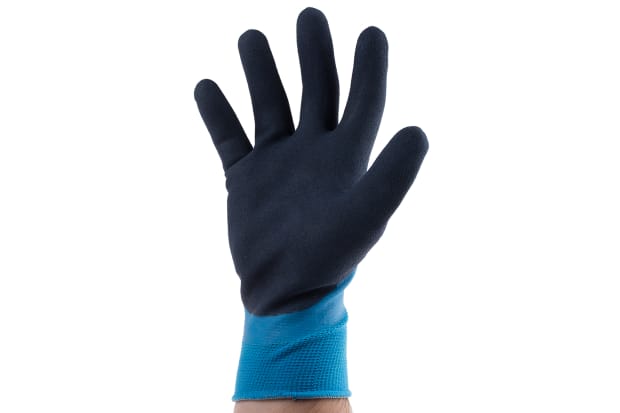
Weatherproof and Waterproof Gloves
Weatherproof gloves and waterproof gloves for use at work are often made from nylon and similar base fabrics. They can feature a variety of coatings or other materials built-in, to help improve performance, value and longevity.
The main function of indoor and outdoor waterproof gloves or weatherproof gloves is to keep the wearer’s hands dry and protected in a range of harsh, wet conditions. Other key features you may choose to look for when buying waterproof or outdoor work gloves can include:
- Close fit with enhanced flexibility to increase user comfort and reduce hand fatigue
- Well-made designs using quality fabrics and materials, with elasticated knit wrist cuffs to improve comfort, fit, weatherproofing, and durability
- Incorporation of other materials for better grip performance, e.g. foam latex palm or finger padding
- Suitability for a broad range of general-purpose uses, especially in wet or outdoor environments
Waterproof work gloves designed for wet and all-weather environments are used by professionals in many fields. Everyday examples include bricklaying, cement handling, general construction, gardening, and local authority outdoor roles.
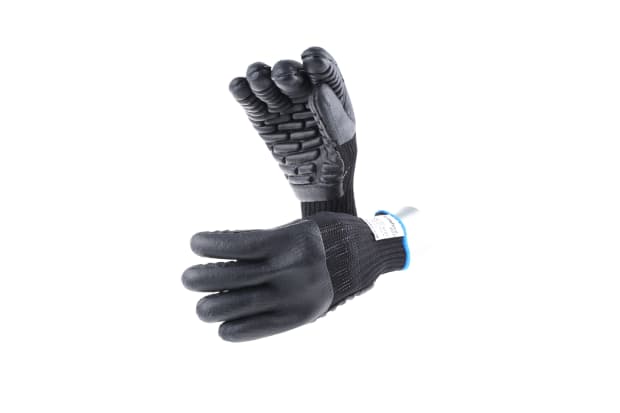
Anti-Vibration Gloves
Anti-vibration gloves are designed to protect the wearer from the effects of prolonged exposure to mechanical tremors. Over time, direct contact with vibrating machinery or tools can contribute to long-term health issues. To prevent this, the user’s hands must be properly shielded.
Anti-vibration gloves in the UK tend to be robust, durable, and thickly padded for optimal cushioning and protection. High-quality options include extensive foam padding on the palm and finger areas for even better anti-impact properties.
These types of gloves are often designed to be worn all day. Many include features such as seamless comfort liners and improved grip. Some models may also use robust external coatings to help protect the back of the hands in various conditions.

Cut-Resistant Gloves
Cut-resistant gloves for work are widely used. They help to reduce the potential for worker injury across countless professions and industries. Everyday examples might include construction, chemical facilities, metal fabrication and welding, food preparation, healthcare, and warehousing.
Quality cut-resistant work gloves are built to meet varying standardised levels of durability. They offer protection against blades, sharp edges, and general tear or abrasion. Materials used to achieve this can include stainless steel mesh and nitrile or polyurethane coatings.
There are five total levels of cut resistance. These reflect the number of ‘cycles’ (slices from a blade or other cutting material) required to fully penetrate the material. In the UK and Europe, we use standard EN388 for tear, puncture, abrasion and blade resistance.
Below, you will find a basic outline of the five cut-resistant glove levels. Note that the cut resistance scale is not linear:
- Cut resistance level 1: 1 x cutting cycle to full severance/penetration
- Cut resistance level 2: 2 x cutting cycles to full severance/penetration
- Cut resistance level 3: 5 x cutting cycles to full severance/penetration
- Cut resistance level 4: 10 x cutting cycles to full severance/penetration
- Cut resistance level 5: 20+ x cutting cycles to full severance/penetration
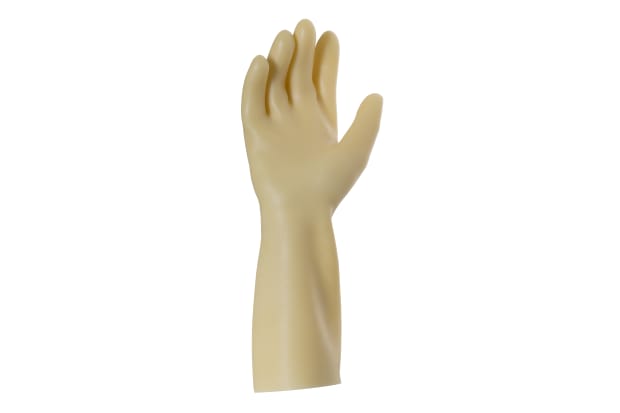
Chemical-Resistant Gloves
Chemical resistant gloves are often sold as chemical resistant gauntlet gloves. This is because they tend to cover more of the arm than many other work glove types. They are designed primarily to protect the wearer from harmful chemical leakages, spills and exposures.
Common materials for chemical-resistant work gloves include natural latex, nitrile, knitted cotton with PVC coating, chlorine-hardened rubber, neoprene, and many more. They often feature textile-lined inner surfaces for added comfort.
Chemical protection handwear can be designed to offer particular resistances for specific environments and applications. Many other variants are made for more general-purpose chemical protection. Both light-duty and heavy-duty types can be found on sale in the UK, depending on your workplace hand protection needs.
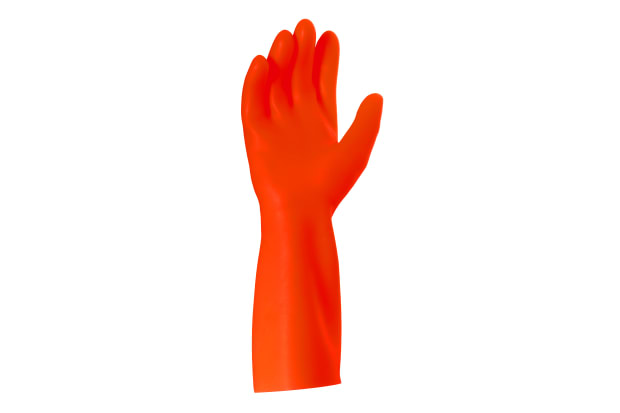
Electrical Safety Gloves
Electrical safety gloves for workplace use can often be found categorised as non-conductive gloves. This simply means that the user is well protected from currents and voltages when working with electrical goods and systems.
To achieve this, electricians’ safety gloves are commonly made from relatively thick materials such as non-conductive natural latex rubber. The main properties of a good non-conductive glove include high dielectric protection (often 1000V) and high strength grip. Enhanced performance even in wet conditions is often advertised.
Electrical safety gloves are typically designed to be close form-fitting on the hand and fingers. This offers improved dexterity when working with components and wiring. They might sometimes feature a gauntlet-style wrist or arm guard, providing additional protection where required. Many models are supplied with cotton interior liners, for improved comfort during extended use.
Electrical safety gloves are also categorised by their classification. Type I electrical gloves are not resistant to ozone, whereas type II is resistant. They can also be categorised by the level of voltage protection they provide, as shown in the table below:
Class | Maximum Use Voltage (AC) |
|---|---|
Class 0 | 1000V |
Class 1 | 7500V |
Class 2 | 17,000V |
Class 3 | 26,500V |
Class 4 | 36,000V |
Fingerless Work Gloves
Fingerless gloves are commonly used in a variety of professions, including:
- Food processing and packaging environments
- General manufacturing and light assembly tasks
- Laboratories, clean rooms, and other controlled environments
There are several benefits to a fingerless style in certain applications. They are mainly used wherever the worker needs to retain optimal fingertip dexterity. They also add a level of protection, padding, comfort or warmth for the palm and back of the hand.
These types of hand covering are also widely used as liner options for outer gloves. This is especially common when the gloves are made from more robust protective materials. A cotton liner can greatly reduce perspiration and skin irritation. For some people, this is also caused by prolonged contact with certain outer materials like latex or PVC.
Warehouse Gloves
In most cases, general-purpose padded or protective gloves can be used as warehouse gloves. The key qualities employees tend to need in gloves for warehouse work are cushioning, comfort and high dexterity. For more heavy-duty goods handling, it is often necessary to include some degree of abrasion and tear resistance.
Construction Gloves
Construction gloves also cover a broad range of product types, including some specialist varieties such as concrete gloves or gloves for carpenters. Again, when shopping for construction work gloves, look for hardwearing or heavy-duty types that offer a degree of cut protection. It is also important that the gloves are breathable and well suited to wearing all day. Weatherproofing may often be needed for outdoor work, or construction tasks involving wet conditions or materials.
Work Glove Features
Many different types of work safety gloves are designed for specific professions. Each type will usually have unique features or qualities that make them ideally suited to a particular environment and application.
However, many gloves offer more general protective feature sets. Below, you will find a rundown of some broader work glove qualities.

Disposable Work Gloves
Disposable work gloves tend to be used for hygiene and protection purposes. They offer very good protection from contamination. This makes them ideal for use in environments such as food preparation, healthcare and medical, or cleanroom and laboratory applications.
Most single-use gloves are relatively thin and lightweight. These offer minimal protection against mechanical abrasion, blades or puncturing. However, more robust models and materials are also available. You can buy versions designed to prevent accidental puncturing, as well as for reliable shielding from hazards such as oils and chemicals.
They are usually sold in bulk, as a cost-effective option for single-use protection in a busy workplace. They can be made from a wide range of materials, including nitrile, latex, neoprene, polyethylene and vinyl. They can be sold as powder-free for reduced contamination risk, or powder-coated for ease of removal.
Heavy-Duty Work Gloves
Heavy-duty hand protection can be made from many different base fabrics and enhancing materials. These range from thick-woven layered cloth, to stainless steel mesh, often categorised by their added strength features. Popular examples are abrasion resistant, anti-tear, or puncture-resistant.
Some heavy-duty types are sold as rigger or rappelling gloves. However, in professional use, these types will each have their own specific requirements for worker comfort and safety. Most heavy-duty gloves tend to be categorised as general-purpose, ideally suited to a broad array of demanding physical or mechanical tasks.
Work Gloves with Grip
Grip gloves are crucial in several different sectors and industries. These include general construction and scaffolding, mechanical repairs, and electrical engineering. Grip gloves are also used in gardening and outdoor work, automotive care, and many other professions. Enhanced grip gloves use a variety of manufacturing techniques and materials to achieve peak performance.
They often feature engineered fabric panels on the palm or fingertips. Some types are also designed to work in a range of wet or hazardous conditions. Grip is often one of the first qualities to become compromised in a more basic glove when wet.
Thin Work Gloves
Thinner materials are often chosen when enhanced dexterity is important for a job. This can include in medical and healthcare facilities, food preparation and catering, on production lines, or for light assembly work. They are also widely used in electrical engineering and laboratory or cleanroom environments.
Thin gloves may be designed to be disposable or reusable. The best choice will depend on the degree of wearer protection or hygiene that is needed in the workplace. Some enhanced versions may be designed as thin gloves with grip. These are ideal for tougher tasks that still require dexterity and reduced hand fatigue.
Padded Work Gloves
Padded models are usually necessary where there is a risk of prolonged exposure to vibration. However, padded gloves can also be extremely handy for general worker protection, for example in all manner of warehousing and general goods handling tasks.
Padding for gloves can be either internal or external, depending on the environment or job they are designed for. Effective padding can be achieved through the layering of various fabric types. Another approach involves using a range of different cushioning materials or coatings in key areas of the glove.
Work Glove Materials
The specific function of a work glove is often dictated by the materials used to construct it. Some especially common choices for work glove materials and their associated qualities include:
- Nitrile gloves. Widely found in both multi-use and single-use products. Often associated with hygiene requirements, as well as for tasks where dielectric properties are important
- Latex and PVC. Also commonly found in both disposable and multi-use products. Note that some individuals can experience skin sensitivities to these materials
- Leather work gloves. Great for a wide range of heavy-duty workplace tasks. Often worn over another thinner layer (e.g. cotton for warmth and comfort, or rubber for electrical insulation)
- Nylon gloves. Nylon is used as a base material for an extensive range of workplace hand protection products. It tends to be comfort-fitting and easy to enhance with a variety of other fabrics and materials for added protection
FAQs
What is a Medium Glove Size?
Glove sizes are typically measured in inches at the widest part (around the knuckles) of the dominant hand. A medium glove size in the UK is a 9. Anything below an 8 is considered small, while anything over a 10 is usually sold as large. Various types, especially single-use products, may be sold as one size where appropriate.
What are the Best Waterproof Work Gloves?
Our own RS Pro Waterproof Nylon Gloves are ideal for tasks like bricklaying, construction, cement handling and gardening. They are a cost-effective solution for reusable gloves, featuring a padded latex foam coating for superior grip in the wet. They are flexible and close-fitting, and also have an elasticated knit wrist for improved comfort.
What are the Best Winter Work Gloves?
Thermal work gloves are a great choice for winter and cold environment tasks. We recommend something like the BM Polyco Thermit, a close-fitting thermal glove made from seamless knitted yarn. It is a close-fitting glove for improved dexterity and can also be worn as a thermal under-glove for added comfort and protection.
What are the Best Gloves for Handling Concrete Blocks?
RS PRO polyurethane (PU) coated work gloves offer very good abrasion resistance for concrete handling and other tough construction jobs. They are also ideal for vehicle repair and general maintenance tasks. High quality and reusable, they offer enhanced tear and chemical protection, making them stronger and more durable than standard versions. They are also CE certified to standard EN407, providing short-term contact protection against temperatures of up to 100°C.
What is the Difference Between Latex, Vinyl, and Nitrile Gloves?
Latex gloves are made from natural rubber. These tend to offer the highest levels of user comfort and flexibility. They are great at protecting against bacteria and viruses, but less mechanically durable than some other materials. Certain people can experience sensitive skin reactions to latex.
Nitrile gloves are also flexible and durable but made from synthetic material. They also tend to offer robust protection against viruses, as well as reasonably robust chemical guarding.
Vinyl gloves are also synthetic in construction. They tend to be a cheaper alternative to nitrile. They may be somewhat less flexible and durable, depending on manufacturer quality levels. They are comfortable to wear, and typically provide good protection against chemical hazards.
Will Leather Gloves Prevent Electric Shocks?
Leather gloves are great at protecting against heat, sparks, and cuts, and will offer some degree of dielectric properties. This makes them ideal for welders. However, leather is not seen as sufficient protection from currents and voltages to make it a standalone solution in electrical tasks. For more heavy-duty mains work or industrial electronics, pair leather outer gloves with an appropriate insulating layer such as rubber for better protection.
